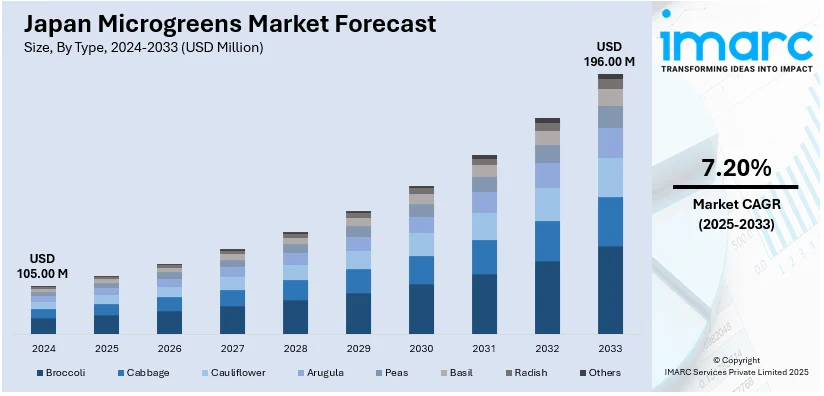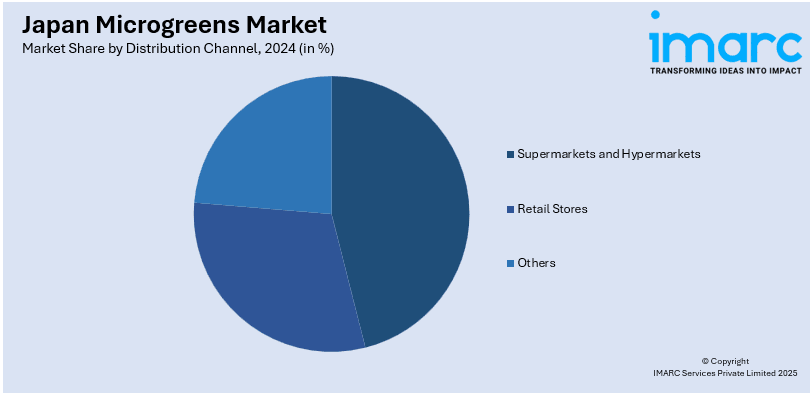
Japan Microgreens Market Size, Share, Trends and Forecast by Type, Farming Method, Distribution Channel, End Use, and Region, 2025-2033
Japan Microgreens Market Overview:
The Japan microgreens market size reached USD 105.00 Million in 2024. Looking forward, IMARC Group expects the market to reach USD 196.00 Million by 2033, exhibiting a growth rate (CAGR) of 7.20% during 2025-2033. The market is growing due to rising health consciousness, increasing demand for nutrient-dense foods, urban farming innovations, expanding fine dining and gourmet trends, continuous advancements in hydroponic and vertical farming, increasing government support for sustainable agriculture, and the surging popularity of plant-based diets.
|
Report Attribute
|
Key Statistics
|
|---|---|
|
Base Year
|
2024
|
|
Forecast Years
|
2025-2033
|
|
Historical Years
|
2019-2024
|
| Market Size in 2024 | USD 105.00 Million |
| Market Forecast in 2033 | USD 196.00 Million |
| Market Growth Rate 2025-2033 | 7.20% |
Japan Microgreens Market Trends:
Growing Popularity of Functional and Nutrient-Dense Foods
The Japanese consumer base is increasingly seeking health-focused products, which are driving the Japan microgreens market growth. These compact, nutrient-rich green plants provide health-conscious consumers with a highly desirable food ingredient. Moreover, the aging population of Japan incorporates microgreens into their dietary plans to get perceived health advantages, including immune system strengthening and inflammation reduction. Besides this, the demand for microgreens also increases due to the clean-label and natural food trend since they are typically cultivated pesticide and fertilizer-free. For instance, in April 2024, the Japanese government has set a goal to convert at least 25% of all farmlands to organic by 2050, a significant increase from just 0.5% in 2020. Urban and semi-urban farmers in Tokyo are adopting environmentally friendly practices to align with this initiative. Furthermore, different eating establishments, including restaurants and cafes, and premium grocery stores feature microgreens as nutritional superfoods for salads and smoothies, along with gourmet meals. Apart from this, the increasing demand for fresh local produce supports urban hydroponic farming of microgreens in metropolitan districts of the region as part of the farm-to-table movement, thereby boosting the Japan microgreens market share.

Expansion of Urban and Vertical Farming
The widespread expansion of urban and vertical farming is significantly enhancing the Japan microgreens market outlook, as it includes scarce farming land along with dense urban populations. In line with this, hydroponic and aeroponic technologies allow producers to cultivate microgreens annually through controlled environments, which produce a steady supply chain. Moreover, the cities of Tokyo and Osaka lead the way in major urban centers as local companies, along with urban farming startups, build high-tech indoor farms to supply their markets. For example, in 2025, Alesca Life introduced a vertical farm in Osaka that operates with 30-60% lower capital expenditure compared to traditional farms. This facility integrates storage and food processing, streamlining the supply chain for microgreens. Concurrently, sustainable agricultural policies backed by government institutions boost the rapid transition towards a more environmentally friendly agricultural system. Similarly, vertical farming becomes a solution to combat climate change and delivery chain problems because it generates dependable fresh microgreens production from local sources. Additionally, the sustainability features and freshness of urban farms make them attractive to restaurants and retailers, helping promote microgreens as mainstream food products. As a result, the Japanese microgreens industry is experiencing improved production efficiency and yield through ongoing advancements in technology, enabling automated farming systems based on artificial intelligence (AI), thus impelling the market demand.
Japan Microgreens Market Segmentation:
IMARC Group provides an analysis of the key trends in each segment of the market, along with forecasts at the region level for 2025-2033. Our report has categorized the market based on type, farming method, distribution channel, and end use.
Type Insights:
- Broccoli
- Cabbage
- Cauliflower
- Arugula
- Peas
- Basil
- Radish
- Others
The report has provided a detailed breakup and analysis of the market based on the type. This includes broccoli, cabbage, cauliflower, arugula, peas, basil, radish, and others.
Farming Method Insights:
- Indoor Vertical Farming
- Commercial Greenhouses
- Others
A detailed breakup and analysis of the market based on the farming method have also been provided in the report. This includes indoor vertical farming, commercial greenhouses, and others.
Distribution Channel Insights:

- Supermarkets and Hypermarkets
- Retail Stores
- Others
The report has provided a detailed breakup and analysis of the market based on the distribution channel. This includes supermarkets and hypermarkets, retail stores, and others.
End Use Insights:
- Residential
- Commercial
A detailed breakup and analysis of the market based on the end use have also been provided in the report. This includes residential and commercial.
Regional Insights:
- Kanto Region
- Kansai/Kinki Region
- Central/Chubu Region
- Kyushu-Okinawa Region
- Tohoku Region
- Chugoku Region
- Hokkaido Region
- Shikoku Region
The report has also provided a comprehensive analysis of all the major regional markets, which include Kanto, Kansai/Kinki, Central/Chubu, Kyushu-Okinawa, Tohoku, Chugoku, Hokkaido, and Shikoku regions.
Competitive Landscape:
The market research report has also provided a comprehensive analysis of the competitive landscape. Competitive analysis such as market structure, key player positioning, top winning strategies, competitive dashboard, and company evaluation quadrant has been covered in the report. Also, detailed profiles of all major companies have been provided.
Japan Microgreens Market News:
- In March 2025, Square Roots Japan announced its focus on growing microgreens, leafy greens, and small fruiting crops. This initiative aims to integrate traditional farmers into the CEA sector, enhancing local production and meeting consumer demand for fresh produce.
- In August 2024, Techstars Tokyo Accelerator, powered by JETRO and Mitsui Fudosan, announced its inaugural class of 12 startups. These companies are addressing challenges in various sectors, including agriculture technology, which could have implications for the microgreens market.
Japan Microgreens Market Report Coverage:
| Report Features | Details |
|---|---|
| Base Year of the Analysis | 2024 |
| Historical Period | 2019-2024 |
| Forecast Period | 2025-2033 |
| Units | Million USD |
| Scope of the Report |
Exploration of Historical Trends and Market Outlook, Industry Catalysts and Challenges, Segment-Wise Historical and Future Market Assessment:
|
| Types Covered | Broccoli, Cabbage, Cauliflower, Arugula, Peas, Basil, Radish, Others |
| Farming Methods Covered | Indoor Vertical Farming, Commercial Greenhouses, Others |
| Distribution Channels Covered | Supermarkets and Hypermarkets, Retail Stores, Others |
| End Uses Covered | Residential, Commercial |
| Regions Covered | Kanto Region, Kansai/Kinki Region, Central/Chubu Region, Kyushu-Okinawa Region, Tohoku Region, Chugoku Region, Hokkaido Region, Shikoku Region |
| Customization Scope | 10% Free Customization |
| Post-Sale Analyst Support | 10-12 Weeks |
| Delivery Format | PDF and Excel through Email (We can also provide the editable version of the report in PPT/Word format on special request) |
Key Questions Answered in This Report:
- How has the Japan microgreens market performed so far and how will it perform in the coming years?
- What is the breakup of the Japan microgreens market on the basis of type?
- What is the breakup of the Japan microgreens market on the basis of farming method?
- What is the breakup of the Japan microgreens market on the basis of distribution channel?
- What is the breakup of the Japan microgreens market on the basis of end use?
- What is the breakup of the Japan microgreens market on the basis of region?
- What are the various stages in the value chain of the Japan microgreens market?
- What are the key driving factors and challenges in the Japan microgreens?
- What is the structure of the Japan microgreens market and who are the key players?
- What is the degree of competition in the Japan microgreens market?
Key Benefits for Stakeholders:
- IMARC’s industry report offers a comprehensive quantitative analysis of various market segments, historical and current market trends, market forecasts, and dynamics of the Japan microgreens market from 2019-2033.
- The research report provides the latest information on the market drivers, challenges, and opportunities in the Japan microgreens market.
- Porter's five forces analysis assist stakeholders in assessing the impact of new entrants, competitive rivalry, supplier power, buyer power, and the threat of substitution. It helps stakeholders to analyze the level of competition within the Japan microgreens industry and its attractiveness.
- Competitive landscape allows stakeholders to understand their competitive environment and provides an insight into the current positions of key players in the market.
Need more help?
- Speak to our experienced analysts for insights on the current market scenarios.
- Include additional segments and countries to customize the report as per your requirement.
- Gain an unparalleled competitive advantage in your domain by understanding how to utilize the report and positively impacting your operations and revenue.
- For further assistance, please connect with our analysts.
 Request Customization
Request Customization
 Speak to an Analyst
Speak to an Analyst
 Request Brochure
Request Brochure
 Inquire Before Buying
Inquire Before Buying




.webp)




.webp)












